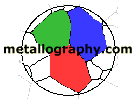
As a final example of the benefit of using alternate illumination modes
Figure 6 shows the microstructure of eutectoid aluminum bronze (Cu - 11.8
wt. % Al) heat treated to form martensite. This structure, in this alloy,
is actually rather difficult to clearly reveal by etching and is revealed
best using an as-polished specimen viewed with crossed-polarized light.

|

|

|

|
Figure 6. Martensite in a heat-treated aluminum bronze (Cu - 11.8% Al) relief polished (non-etched) specimen viewed with: (top left) brightfield; with (top right) crossed-polarized light; with (lower left) darkfield; and, with (lower right) differential interference contrast illumination. (200x)
Figure 6 (top left) shows the image viewed with brightfield. Because it was not etched, the structure is not clearly revealed. In this case, polishing has produced some relief so that the brightfield image does contain some information. Figure 6 (top right) shows that crossed-polarized light produced a vivid, bold presentation of the martensite. Because of the surface relief, both darkfield (Figure 6 lower left) and DIC (Figure 6 lower right) revealed the martensite phase, although not as well as polarized light.
Go To: |
Previous Page |
FAQ |
Home |
Search |
Vendors |
|---|